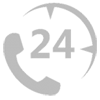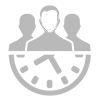Outgoing calls in a Call Center: practical application
Call centers have long been widely used in the domestic market, but their use, as a rule, is associated with servicing only incoming customer calls. At the same time, industrial solutions for call centers are effectively used worldwide for outbound dialing campaigns. In Ukraine, outbound dialing systems are popularized by an increase in the size of the target audience for telemarketing (in all its manifestations), increased requirements for the representativeness of social and marketing research, as well as tasks related to the collection of «bad debts» (Collection). In this post I want to understand in more detail the concept of «outgoing calls» and consider some examples of its effective application in a Call Center.
Most often during mass calls in the Call Center, the Preview or Predictive modes are used. The key difference between them (without being tied to technology) is the degree of «involvement» of the Call Center operator in the call process.
Outgoing calls in Preview mode
A feature of this mode is that the operator is provided with a certain «degree of freedom» when calling. The Call-Center operator can independently, for example, determine the sequence of dialing, choose to call or not call one or another number (for example, refuse in case of a clear error in the number).
There are many solutions on the market for this outgoing call mode, but all of them can be conditionally divided into two groups.
The first group includes solutions based on the integration of information systems (CRM solutions or specialized applications) with office (corporate) telephony. Those. These are the various options for CTI applications. If we ignore the tasks of forming lists and analyzing the results of the calling campaign, then in essence this is an ordinary «auto-dialing». In case of «linking» several telephone numbers to one contact, the operator will indicate which number needs to be dialed. The solutions of this group allow minimizing the likelihood of errors when dialing a number and somewhat reduce the «load» on the operator during work.
Most often, such solutions are used to call a specific person a specific list of numbers. For example, the manager of a B2B company forms a list of its clients in the CRM System and makes a call on this base.
The solutions to the second group, as a rule, are used directly in Call Centers and are more consistent with the «established» concept of Preview. In this case, the system, before making a call, «asks» the operator each time about his readiness to contact the selected client (subscriber) and, if the answer is yes, he will dial up the phone numbers indicated in the list. The key difference from the decisions of the first group is that a common call list is formed for a group of Call-Center operators and the system automatically distributes clients between them.
It is most advisable to use this mode with a small number of operators that solve the same type of outgoing call problems, as well as for solving «one-time» tasks. For example, for market research with a small number of respondents.
Predictive outgoing calls
In Predictive mode, each «free» Call Center operator is assigned a certain number of softphones (dialers) that make automatic calls according to the campaign list. The system switches the call to the operator only if dialing to a «live» person has been made on any line. As mentioned in Vasily Tokarchuk’s CRM blog, using the Predictive mode in the Call Center allows you to increase the operator’s talk time from 30% (of the total work time) in the same Preview mode to 80%. This is achieved due to the parallel execution of many calls (the system calls on several phones of different clients at the same time).
For example, we will carry out the following simple calculation, the initial data for which are confirmed in practice at one of the latest projects. If the average dial-up time for one number is 30 seconds and only every fifth call leads to dial-up to a «live» person, then in case of using the Preview mode, the average dial-up time will be 2 minutes 30 seconds. When using Predictive, the average dial-up time will be only 30-60 seconds (the time spread will vary depending on the number of call-center operators, system settings, etc.).
This outgoing call mode is the prerogative of mainly leading manufacturers of call centers (due to the complexity of the implementation), but, as in the case of the Preview mode, there are several options for implementing the Predictive mode.
In the first, most common cases, the system itself calculates the optimal operator-dialer ratio for operators who are in a state of readiness for making a call. The system provides parallel dialing based on this ratio and in the case of a response from a «living» person, they switch it to a «free» operator. The calculation of the ratio is based on the settings and accumulated statistics. A key advantage of the Predictive mode is the ability to predict «loading» operators and making «proactive» calls.
It is most advisable to use this mode for mass calls, in which more than ten operators are involved. The more operators, the more accurate statistics the system receives, which allows it to reduce the «downtime» of Call Center operators. As practice shows, if in the Preview mode the best operators manage to make 110-120 «effective» calls per shift, then under the same conditions in the Predictive mode the average figure exceeds 200 calls.
The second embodiment of the Predictive mode involves «manually setting» the «operator-dialer» ratio. In this case, there is no possibility of making «preemptive» calls and the system makes a predetermined number of simultaneous calls (based on the ratio) as soon as the operator switches to the «ready» status. This mode is usually used with a small number of operators.





